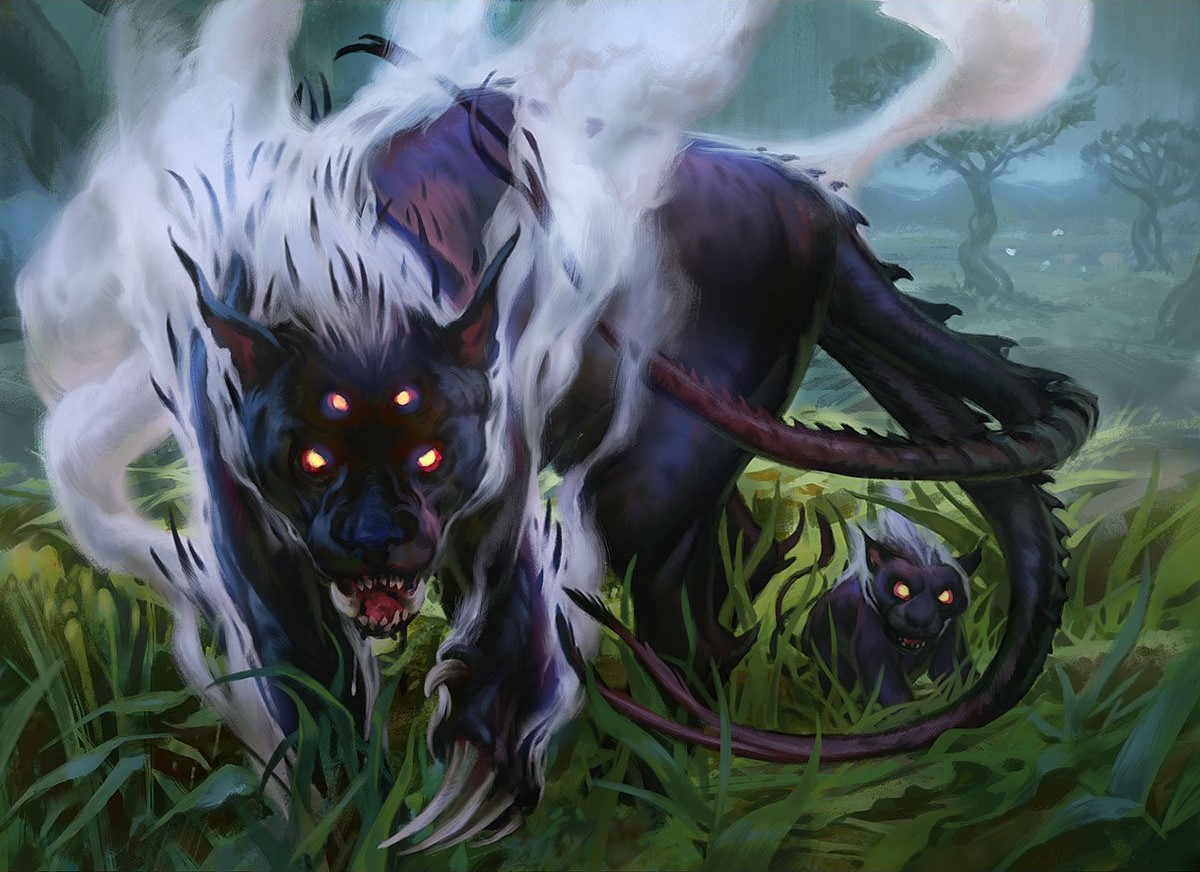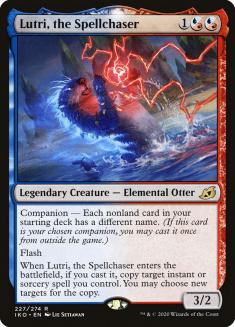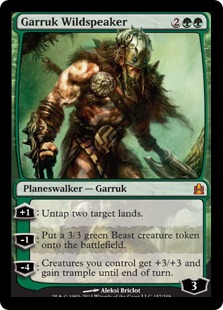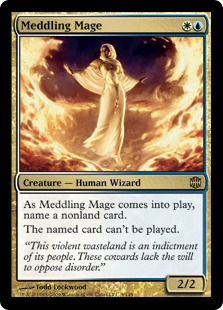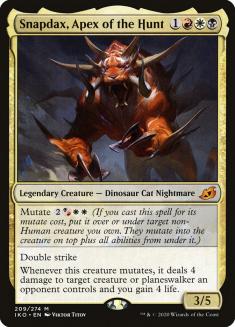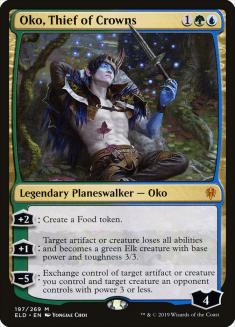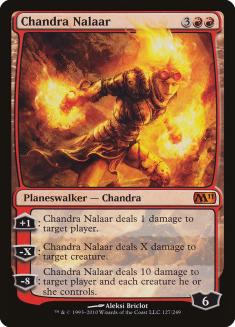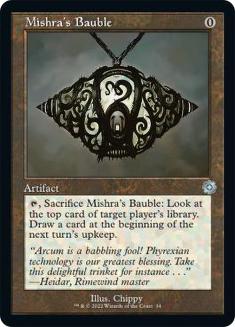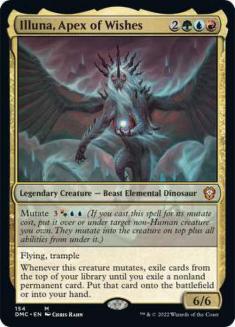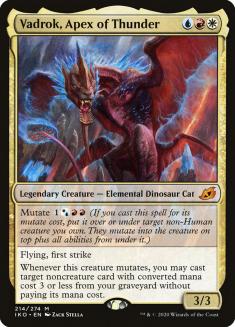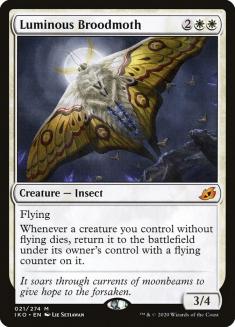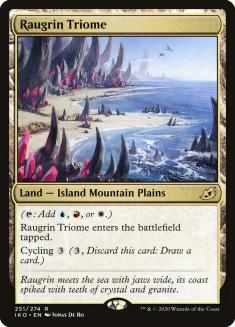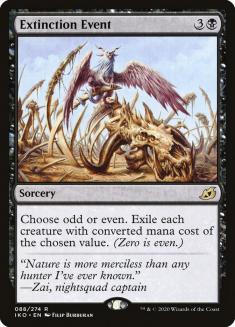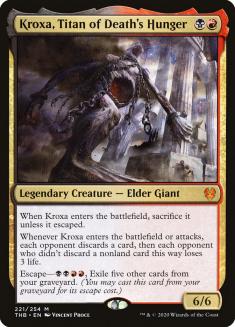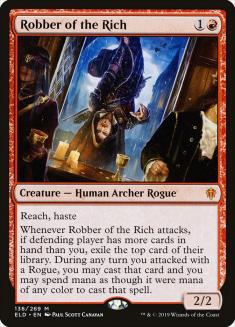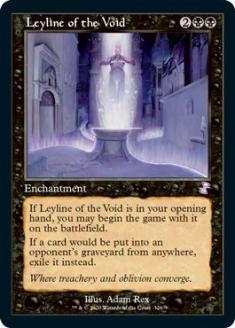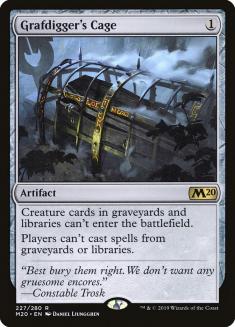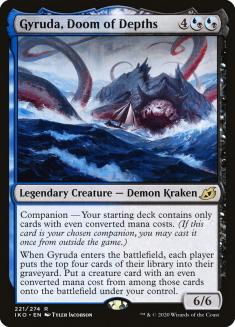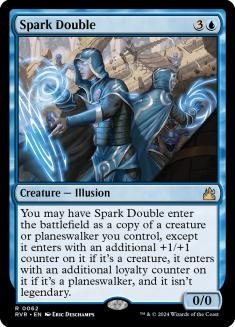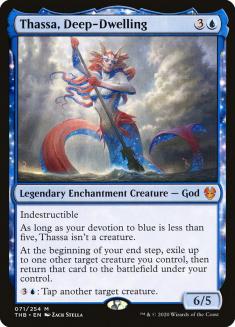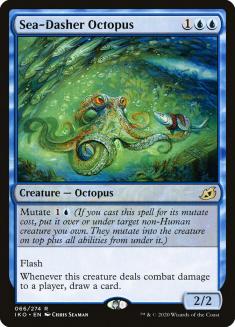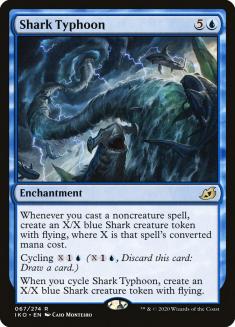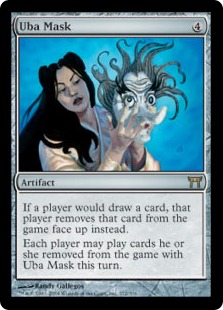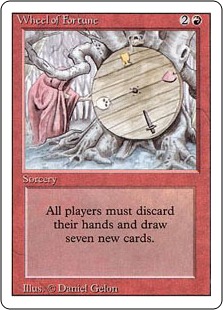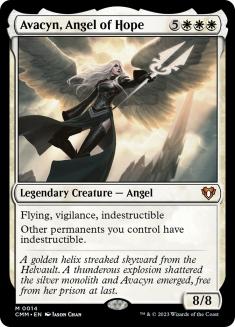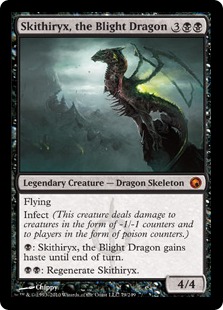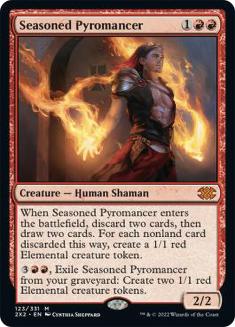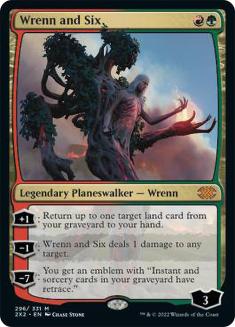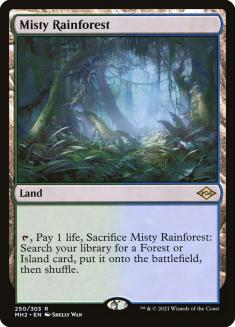I can’t believe that Ikoria: Lair of Behemoths has only been out for a week on Magic Online (MTGO) and Magic Arena (Arena). We’re still two weeks away from the set’s tabletop release, and most of us won’t even be able to visit our local game store for another few weeks after that. It’s hard to imagine that any set released right now could make so much as a tiny splash, much less feel like a massive cannonball into the very fabric of competitive Magic.
And yet…
Perhaps the writing was on the wall when Lutri, the Spellchaser was banned in Commander less than twenty minutes after being previewed, but most of us still managed to underestimate just how game-changing the companions would actually end up being in competitive Magic. I certainly did. Even when I warned that companions ran the risk of being the most broken mechanic since Phyrexian mana, that still sold them short. I was worried that companions had a shot of being a 10/10 in power level, but the reality is that they’re more like a 15/10. One week in, and I’m already shocked whenever I see a competitive decklist without a companion. I can’t remember the entire competitive Magic sphere ever having such a quick and massive shift. I don’t think it has ever happened before.
This week, we’re going to have a talk about companions, as well the other expensive cards in Ikoria that have begun permeating the competitive Magic scene. There are just so many questions we have to answer here. Are the companions going to be banned, or are they here to stay? Should you be buying them right now, or staying away? Should we be buying or selling the support cards like Mishra’s Bauble that have spiked incredibly hard over the past few days? And is the sea change we’ve seen over the past few days Magic’s new normal, or is it just a weird blip in the game’s history?
Let’s talk.
What Companions Have Done so Far
It’s getting hard to find tournaments where companions aren’t dominating the top tables.
For example, here are the results of a Standard Super Qualifier from April 21. Gyruda, Doom of Depths was at the time banned on MTGO due to a coding error, and there was still just one companion-free deck in the Top 8. Ditto for this Standard Preliminary on April 23rd. On the same day, there was a companion in every single Top 8 deck in this Pioneer Super Qualifier. Things aren’t quite as extreme in Modern, but companions still captured two-thirds of the top spots in this Modern Preliminary and that seems low compared to other numbers I’ve seen tossed around on social media. I could go on and on, but you get the idea. Even Legacy and Vintage are being overrun by Lurrus right now. It’s wild.
Granted, strange things have happened the first week after a set release before. Cards like Boros Reckoner and World Breaker have looked unbeatable in Standard, only to end up proving incredibly beatable over the next several weeks. But the companions don’t look like flashes in the pan, and it takes a lot for a card to suddenly warp the metagame in a format where Black Lotus is legal like Lurrus has. I expect that the next few weeks are going to be less about “How do we beat companions?” and more about “How do we build around our companion of choice?”
Are Companions Here to Stay?
Three years from now, we’re either going to look at Ikoria’s companions similarly to the way we look at Phyrexian mana, or we’re going to think about them the way we think about Lorwyn‘s original five planeswalkers.
Setting the obviously overpowered Lurrus of the Dream-Den aside for a moment, most of the sturm und drang about the companion mechanic seems to have more to do with how fundamentally they change the landscape competitive Magic than it does with the cards simply being too good. Much like with the London Mulligan and the addition of planeswalkers, games of Magic tend to be a whole lot different when everyone has guaranteed access to an extra card. There are compelling arguments to be made that this is a poor direction for the game and it will lead to homogenized gameplay down the line, but you could have made similar cases about both planeswalkers and the London Mulligan in their day. It seems possible to me that Wizards of the Coast (WotC) will fully embrace the companion path as they design and develop future sets.
I’m not convinced that WotC leaning into companions is a bad idea at this point, either. Assuming a majority of them aren’t banned in all eternal formats, it’s going to be exhausting to see the same half-a-dozen cards show up in nearly every match of Modern, Legacy, and perhaps even Pioneer over the next several years. So why not simply print a few new ones in each set? Commander wouldn’t be very much fun if there were only ten commanders, after all.
Why is this important to figure out from a financial perspective? Because the future of Magic is going to look a lot different if almost every deck ends up having to fulfill some sort of wacky condition in order to gain access to a companion than it will if WotC uses bans or rules changes to walk this back. For instance, the fact that discard spells can’t hit companions but counterspells can means that the former are likely to see a major downtick in play going forward. Thoughtseize is currently the #2 most-played card in Pioneer, but if companions are here to stay, it might make sense to cash in your set if you’re not using them right now. On the flip side, Meddling Mage could easily end up being one of the two or three most-played cards in Modern now that it’s nearly guaranteed to have an obvious target. (Incidentally, Meddling Mage is a pretty fantastic card to buy right now.)
At this point, I’m operating under the belief that companions aren’t going anywhere. A few of them might eat a ban, and it might be a little while before WotC prints any more, but the play patterns and overall thrust of the mechanic don’t seem out of line with WotC’s current design philosophy. The folks angling for companions to essentially be regulated out of all the eternal formats may have a solid argument, but I think they’ll end up on the losing side of history.
The Two Best Companions Are Pretty Expensive Right Now. Will It Last?
These are the current retail prices for all ten companions:
- Lurrus of the Dream-Den – $18
- Gyruda, Doom of Depths – $10
- Jegantha, the Wellspring – $3
- Obosh, the Preypiercer – $3
- Kaheera, the Orphanguard – $3
- Yorion, Sky Nomad – $3
- Zirda, the Dawnwaker – $3
- Lutri, the Spellchaser – $2
- Keruga, the Macrosage – $1.50
- Umori, the Collector– $1.50
At first, I didn’t really understand this list. I get why Lurrus is worth almost twice as much as the next-best companion, but why is Gyruda up at $10 while the nearly-as-powerful Yorion is just $3? And why is Keruga, the Macrosage, perhaps the most popular Standard companion right now, just $1.50 while the underplayed Kaheera is still up at $3? It just didn’t make sense.
So I did some research and learned that there are a few really important factors at play here. Let’s talk about each of them in turn.
First, the cheaper companions are probably just straight-up underpriced right now. Keruga, the Macrosage has basically taken over Jeskai Fires, so it should not be the cheapest companion on the market. Yorion, Sky Nomad is quickly proving a beast in Modern, Pioneer, and Standard — it should be worth more than $3. Obosh, the Preypiercer is getting into the action in all three of those formats, and cards like Kaheera and Jegantha have shown promise as well. Put simply: if Lurrus is worth $18, than the cards I just mentioned should be worth at least $4-$5 each.
Second, Gyruda, Doom of Depths’s top-heavy price tag makes sense once you learn that Standard Gyruda Combo runs three copies of its namesake card in the maindeck in addition to the copy it runs as a companion. Based on this fourfold increase in demand over its compatriots, the $10 price tag here seems fair and sustainable.
This brings us to our third factor: it’s still not clear to me where the rest of these companions will eventually settle, because mostly players are only ever going to need one copy of each. I talked about this at length in my three-part Ikoria Financial Set Review, and it’s the biggest thing keeping Yorion’s and Keruga’s prices low right now. This might create a situation where all of these cards are heavily played but are still fairly cheap over the short term. Eventually, I do expect all of these cards to spike as future generations of Magic players realize that owning a set of the ten Ikoria companions should be pretty much mandatory going forward.
That brings us to our fourth (and most important) wrinkle: Ikoria hasn’t actually had its North American tabletop release yet. This is unprecedented. For every other set that’s ever been released, physical copies of each card have been available for purchase during the hype period after the first week or so of tournament results. And while it’s true that you can click over to the Star City Games store and buy all ten companions right now, you’ll still have to wait a few weeks for them to ship. Otherwise, we’re locked out of Ikoria except for Arena and MTGO. We can’t buy booster packs. We can’t draft or play Sealed Deck. We can’t trade singles with our friends. Nothing.
This is a big deal when it comes to card pricing. If there aren’t actually any Ikoria cards entering the market, there’s not going to be much downward pressure on the cards that we’re all trying to buy. Oh, sure, the cards that end up being busts will come down in price as stores continue to drop the value in order to sell copies, but that’s not going to cause cards like Lurrus to lose value. In fact, Lurrus might end up kicking around the $20 range for another month simply because Ikoria is late to market.
It’s hard to know what will happen in the future when we’ve got so many unpredictable factors in play — a delayed release, a pandemic, a powerful new mechanic that is unlike anything we’ve seen before — but if I had to guess, I’d say that Ikoria prices will remain unusually high throughout May, if not longer. We probably aren’t going to get our hands on any of these cards until mid-month, and even then we know that the initial print run will be lower than average. After that, it’ll still take at least a few more weeks for a significant number of these cards to actually hit the market. If a card like Snapdax, Apex of the Hunt ends up being a total no-show before that, it’ll still drop in price a bit, but I can’t imagine any of the most proven cards will drop off much, if at all.
After that, we’ll see. Prices may drop quite a bit if the new metagame ends up being oppressive or if we’re still not able to play in any paper events by mid-June. This is also where the singleton nature of the companions might start to depress demand for cards like Lurrus and Yorion. But Ikoria is always likely to be a somewhat under-opened set due to the state of the world right now, so these cards will probably end up being pretty expensive over the long haul. If they do tank during the summer months, they should perk back up again as soon as the world returns to normal.
Should we be buying companions right now, then? Well, I’d absolutely grab a set of the eight companions that are currently selling for $3 and less, and I’m also tempted to snap up Gyruda, Doom of Depths at $10. Lurrus of the Dream-Den is going to require a more in-depth discussion, however.
Will Lurrus of the Dream-Den Be Banned Soon?
Imagine if Oko, Thief of Crowns had been one of the first five planeswalkers ever printed instead of, say, Chandra Nalaar. Would we have all instantly dismissed planeswalkers as beyond overpowered or would we have been able to recognize Oko for what it was?
The entire companion mechanic might eventually end up proving too good, too homogenous, or problematic in some other way. It will likely be a while before we can say for sure. But for now, I think it’s worth discussing Lurrus as its own problem, apart from the other nine companions.
I’m not ready to say that Lurrus deserves a ban, or predict that it will definitely get a ban, after a single week of play. Lurrus looks fine in Standard at the very least, where there are fewer ways to completely abuse its recursion ability. It’s certainly possible that the other formats will find ways to adjust. But if you were to plot out Lurrus’s first week of legality in the eternal formats, it’s hard to argue that it’s not currently on a trajectory that will eventually lead to a banning in Modern and Legacy.
Will WotC even think about banning a card like Lurrus before Ikoria even hits shelves? I doubt it. I also feel like Lurrus might get a fairly long leash in Modern because you can jam it into so many different decks. I’ve seen Lurrus show up in Death and Taxes, Burn, Humans, Grixis Control, Grixis Midrange, Jund, and a few others. Even if Lurrus is everywhere and Modern feels entirely different for a while, WotC will want to wait until folks have had a chance to buy their boxes of Ikoria and play with their new cards before taking action if at all possible.
It’s also possible that WotC will attempt to ban around Lurrus, like they’ve tried in the past with cards like Hogaak, Arisen Necropolis. In this case, Mishra’s Bauble would seem the most likely target for WotC’s hammer. Mishra’s Bauble is the sort of cheap library manipulation that WotC doesn’t really like to have in Modern anyway, and the little artifact is straight-up absurd with Lurrus. Mishra’s Bauble has started to pop up all over Modern over the past week and I expect that trend to continue.
Should you avoid buying Baubles right now because of these banning fears? I wouldn’t. The card spiked from 25 tickets to 55 tickets on MTGO last week, but its paper price hasn’t budged much at all yet. It’s currently sold out at $6.99 on Star City Games, and they’re still kicking around the $10 range for now, which seems like a deal still. Granted, the card is a lot more prevalent in paper than it is on MTGO due to the different distribution rates of Iconic Masters, but Mishra’s Bauble has a long way to climb before we really have to worry about a potential banning. If you buy in at or near the $10 mark, you should be able to play with them for a couple of months and still sell them at a profit.
As for Lurrus itself, I think $25 is probably close to its short-term price ceiling. You can snag your copy now at $18 if you want — you only need one, after all — but it could drop in price once people start opening packs and the ban talk starts up in earnest. The card should remain legal in Standard, though, so the floor is probably something like $5-$6 instead of total bulk. You’re not going to make money buying Lurrus right now, but you probably won’t lose much, even in a worst-case scenario.
The Non-Companion Winners and Losers from Ikoria’s First Week
So far, it appears as if the new Standard metagame is severely lacking in “fair” midrange decks. If you want to compete, you must have a way to go over the top or combo out, or else just try to be really, really fast.
So far, I haven’t seen much of anything out of the various Apexes. They’re all quite powerful in a vacuum, but as of now it looks like there just simply isn’t a place in the format for a deck that wants to try to play these creatures in order to grind out card advantage. That’s simply not going to beat the Cat/Oven combo; Gyruda, Doom of Depths; or Fires of Invention.
Sadly, the same is looking true for Luminous Broodmoth right now. The card has gained $10 since we first talked about it, surging from $15 to $25, mostly as a result of how stellar it looked in early testing. And while Luminous Broodmoth is still objectively one of the more powerful cards in the format, I’m starting to wonder if it’ll fail to make much of an impact in the current metagame.
The one place I have seen Luminous Broodmoth show up? Gyruda Bant Midrange. This is less of a true midrange deck and more of a midrange combo deck, but it’s one of the coolest new brews in the format regardless. I’m not sure if showing up as a two-of in a single deck is going to be enough to keep Luminous Broodmoth over $20 for long, but it has kept the card from dropping off in price yet.
Creatures (25)
- 4 Paradise Druid
- 4 Spark Double
- 3 Elite Guardmage
- 2 Charming Prince
- 3 Thassa, Deep-Dwelling
- 2 Luminous Broodmoth
- 3 Gyruda, Doom of Depths
- 4 Humble Naturalist
Lands (21)
Spells (14)

If no other midrange decks end up developing soon, I’d sell my extra copies of Luminous Broodmoth and look to buy in again as a post-hype sleeper. I still feel like Luminous Broodmoth will have its day in the Standard sun, but I’d rather see if I can snag my copies for $5 each in August and hope to sell into the next wave of hype come October.
I’m sure none of you are shocked to learn that Jeskai Fires is still the most-popular deck in Standard, though it’s the Keruga Jeskai Fires variant that can now claim to be the format’s top dog. There aren’t too many Ikoria cards in this deck save Keruga, the Macrosage, but I wanted to highlight Raugrin Triome as a Week 1 success story. The deck runs a full four copies of the new rare cycling land, and it’s still sitting at its starting price of $12.99. If any of these lands is going to increase in value over the next few weeks, it’ll be this one.
Rakdos Sacrifice was a pretty solid deck before the release of Ikoria, but Lurrus Rakdos Sacrifice is quite a bit better. This is clearly going to be one of the decks to beat going forward, and it’s one of the few builds in the format that can assemble a quick kill right now. Much like with Keruga Jeskai Fires, Lurrus Rakdos Sacrifice doesn’t use a ton of cards from Ikoria save its namesake companion. I’ve seen Extinction Event showing up as a sideboard four-of, though, so I’d at least consider nabbing a set of those right now. I also expect we’ll see gains from some of the deck’s other key pieces, like Kroxa, Titan of Death’s Hunger; Robber of the Rich; and perhaps even Dreadhorde Butcher.
The more we see Lurrus, the more we’re going to need graveyard hate to beat it. This is even going to be true in Ikoria Standard, where you can’t just let Lurrus sit around looping Dead Weight and Mire’s Grasp all day.
Leyline of the Void and Grafdigger’s Cage are both Standard-legal, and they’re about to surge in popularity now that they’re solid metagame calls against even more of the format’s top strategies. Buying in now is a no-brainer — not only will you need these cards for Standard, but they’re likely going to see a spike in play (and price) across all the eternal formats as long as Lurrus is allowed to keep doing Lurrus things.
We’ve talked a little about Gyruda Bant Midrange already, but I wanted to highlight the deck again here. Not only is this brew the reason that Gyruda is up to $10, but it has also caused Spark Double to more than double from $3 to $7. I was hoping to pick Spark Doubles up over the summer as a long-term Commander spec, but alas. This card is so heavily backstopped by casual demand that I can’t really see the price dropping below $5 now.
Thassa, Deep-Dwelling is my sleeper pick here. Most of the Gyruda builds I’ve seen run 3-4 copies of this Theros Beyond Death God, yet its price tag hasn’t budged yet. You can still snap them up all day long on Star City Games for just $11.99. If Gyruda is really worth $10, this mythic rare is absolutely worth more than $12. I wouldn’t be shocked if it ends up in the $20-$25 range as soon as we’re back in a world where we can all play Ikoria Standard in person again.
Sea-Dasher Octopus and Shark Typhoon are clearly just excellent cards. They looked great in theory during previews, and they look equally great in practice now. I’ve seen both cards showing up in pretty much all the decks where it makes sense for them to exist: Sea-Dasher Octopus is in Simic Flash and Mono-Blue Aggro, while most of the Yorion decks and Temur Reclamation are using Shark Typhoon.
I was high on both of these cards during my Ikoria set review, and I wasn’t surprised to see either of them make modest gains over the past week. Expect them to maintain their elevated price tags moving forward.
This Week’s Trends
We’ve already talked a lot about this week’s competitive trends, but there have been a couple of Commander spikes over the past few days as well. First, Uba Mask jumped from total bulk to about $4 (it’s sold out at $2.99 on Star City Games) due the combo potential it has with Drannith Magistrate. Get these two cards on the battlefield together and you can lock your opponents out of drawing any new cards at all. This seems a bit slow and fiddly for Constructed, but it’s a neat little casual interaction. I’d expect Uba Mask to settle in around the $2-$3 range once the hype has died down a bit.
Second, it appears as though someone bought out Wheel of Fortune again. The Reserved List staple is one of the best cards in Commander, and it plays nicely with half a dozen of Ikoria‘s sweetest new toys. I didn’t see this coming because Wheel of Fortune was already selling for a cool $100, but it looks like someone is intent on trying to push that up to $150. I’m not sure if they’ll succeed, but these buyouts usually result in at least a short-term price spike.
Also up this week in thanks to Commander: Avacyn, Angel of Hope and Skithiryx, the Blight Dragon. Avacyn is up about $10 due to its power in combination with Kathril, Aspect Warper, while Skithiryx is a pretty excellent card to pair with a giant mutate stack. These cards have been among the most popular commanders for years, and it appears as though these price spikes are more organic than Wheel of Fortune or Uba Mask. Don’t expect a drop in price any time soon.
Over in Modern, several long-term staples are rising as the entire format’s index has come back to life in recent weeks. Misty Rainforest continues to gain between $5 and $10 each week, while Verdant Catacombs also jumped another $7 since the last time we checked in. A couple of the better Modern Horizons cards have also started getting frisky, with both Wrenn and Six and Seasoned Pyromancer experiencing $10 gains over the past week.
Between the government stimulus checks and the metagame shake-up, Modern appears to be fully trending upward for the first time in 2020. I’m not sure how long it’ll last — the lack of upcoming paper tournaments makes everything pretty hard to predict — but I bet we’ll be talking about more gains over the next couple of weeks at least.

